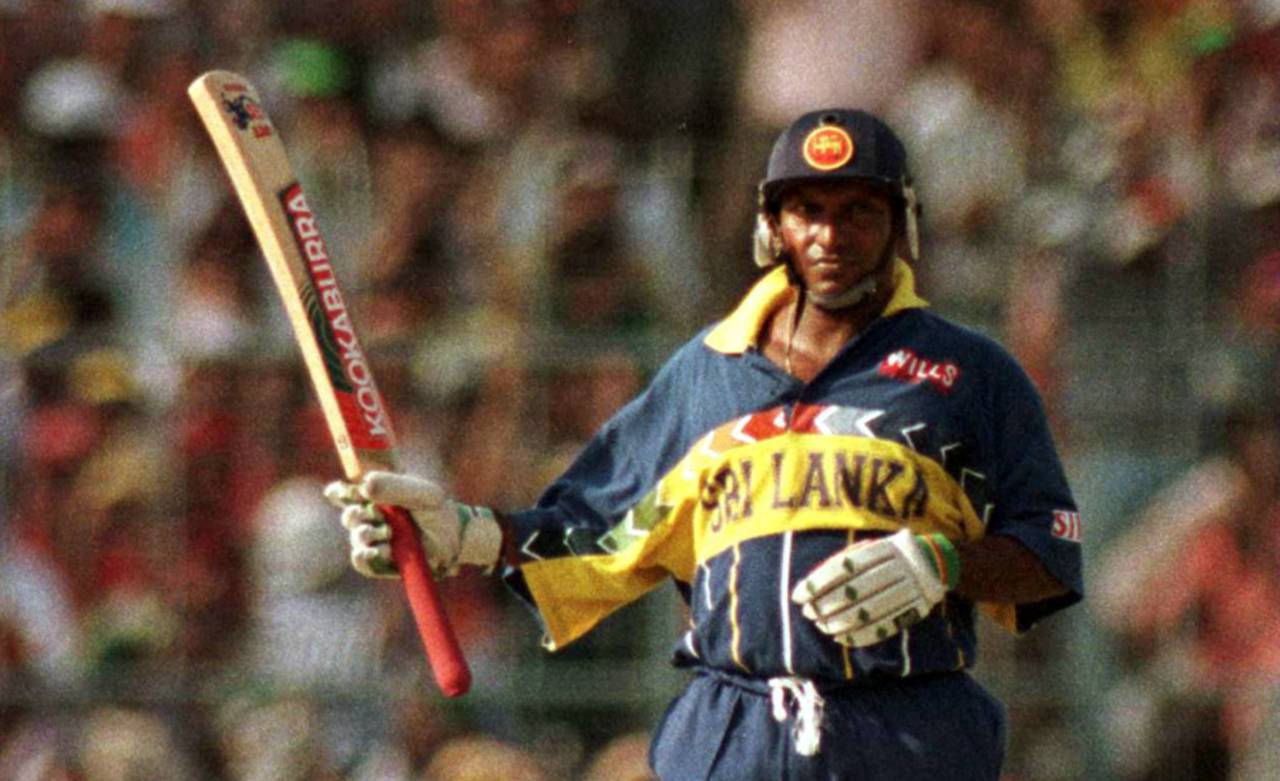All hail Mad Max
Aravinda de Silva's steely resolve at the crease, as demonstrated in the 1996 World Cup final, coupled with his vintage strokeplay made him the first true Sri Lankan great
Janaka Malwatta
08-Mar-2015

Aravinda de Silva saved his best for the 1996 World Cup • Getty Images
Aravinda de Silva was Sri Lanka's first international cricketing superstar. Before Sanga, before Mahela, before Murali, before Sanath, there was Aravinda. Diminutive, effortlessly graceful, equally adept in Test and ODI arenas, he was a batsman for the ages. His tale, like those of so many of cricket's artists, is not captured by facts and figures alone. He did score 6361 Test runs, the fourth-highest aggregate for a Sri Lankan, including 20 centuries. He also has 9284 ODI runs and over a hundred ODI wickets. But the true measure of his career is in the memories he has left us.
Aravinda was born to play cricket. "Cricketer was written all over him - in his walk, in the way he took guard, in his stand at the wicket," wrote PG Wodehouse of the eponymous hero of his novel Mike at Wrykyn. "On the cricket field, he could not have looked anything but a cricketer if he had turned out in a tweed suit and hobnail boots." Those words could have been written for Aravinda de Silva.
A short man - he was 5ft 4in - Aravinda's bat always looked disproportionately long, as if he had borrowed his big brother's when he wasn't looking. But what magic he conjured with it. Like most men of his stature, Aravinda was an expert puller and cutter. But allied to these power shots were late cuts of the utmost delicacy, leg glances of indescribable finesse, rapier-like cover drives, impossibly angled square drives. Aravinda scored all round the wicket without slogging: classically correct cricket shots executed with precision and panache. He was the RK Narayan of cricket. Narayan's liquid prose is so smooth, so polished, it feels like a miracle of nature. Aravinda at the crease was Narayan in Malgudi.
Throughout his career, Aravinda's instinct was to attack early and often. When he first came into the national side, he had a predilection for attractive but doomed cameos. But as he matured, he constructed a series of innings full of beauty and swagger, bravura and subtlety, which can be tucked away in the memory to savour through the years. Aravinda made a speciality of taking the fight to the bowlers. Against Pakistan in Sharjah, he hit the fearsome Waqar Younis back over his head, pulled Wasim Akram dismissively, and then played the most exquisite late cut off Mushtaq Ahmed. At the Gabba, of all places, he took on an Australian pace attack boasting Carl Rackemann, Merv Hughes, Geoff Lawson and Terry Alderman, scoring 167. In 1991 he carved his way to a career-best 267 against New Zealand. But two of his limited-overs innings burn brightest in my memory.
He is the RK Narayan of cricket. Narayan's liquid prose is so smooth, so polished, it feels like a miracle of nature. Aravinda at the crease is Narayan in Malgudi
I am particularly fond of his century for Kent against Lancashire in the 1995 Benson and Hedges Cup final, not least because it considerably brightened up a dreary on-call Saturday. He put all his wares on display, warming-up with two pulled sixes, culminating in a succession of inside-out lofted cover drives, each the result of twinkle-toed footwork, all immaculately placed. The stroke of the day was a one-handed square drive which came off the bat like a pistol shot. Even in a losing cause, Ian Botham named him Man of the Match.
Aravinda's most enduring performance was in that triumphant 1996 World Cup final in Lahore. Truly he danced with the gods that night. He was always in the match, and took 3 for 42 and pouched two catches, but mere statistics do not reveal the size of his contribution. Australia, overwhelming favourites, made steady progress to 137 for 1, with all the imperious inevitability of a dreadnought. Aravinda made the critical breakthrough, taking the crucial wickets of Mark Taylor and Ricky Ponting, ending their century stand in the process.
When Sri Lanka batted, he came to the wicket with the score on 23 for 2. With Asanka Gurusinha, he took the fight to an Australian attack consisting of Glenn McGrath and Shane Warne. His innings was a characteristic mixture of power and delicacy, of blistering cuts and the finest leg glances. He even produced another one-handed square drive. But as he demonstrated in a duel against Warne, he was not only a master strokemaker, he was a master of placement. He cut Warne to the point boundary, penetrating a circle of three fielders between short cover and point. Warne reinforced the field with a fourth fielder. Impossibly, next ball Aravinda smote a back-foot drive past all of them.
Perhaps his greatest achievement that night was the resolve he showed. His innings was not to be a pretty cameo. There was steel in his eyes. After Gurusinha fell, he guided the innings home in the company of captain of war Arjuna Ranatunga, with almost four overs to spare. Aravinda the stylist had become Aravinda the match-winner. His 107 in 124 balls made him the third man after those two great West Indians Clive Lloyd and Viv Richards to score a hundred in a World Cup final. The choice for the Man of the Match was never in doubt. Nor is his place amongst cricket's immortals.
Janaka Malwatta is a poet, doctor and cricket lover who lives in Brisbane. @janakamalwatta